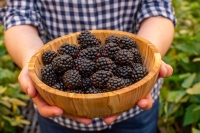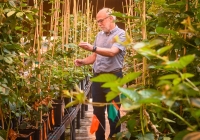Plant breeders, by nature, are patient people. It can take them years or even decades to perfect a new variety of fruit or vegetable that tastes better, grows faster or stays fresh longer.
But their work has taken on a new urgency in the face of an increasingly erratic climate. Recent floods left more than one-third of California’s table grapes rotting on the vine. Too much sunlight is burning apple crops. Pests that farmers never used to worry about are marching through lettuce fields.
Breeding new crops that can thrive under these assaults is a long game. Solutions are likely to come from an array of research fronts that stretch from molecular gene-editing technology to mining the vast global collections of seeds that have been conserved for centuries.
And, of course, the new fruits and vegetables have to taste good. "You can use these technical solves to find climate solutions, but they won’t be useful if it’s not what people want to eat,” said Michael Kantar, an associate professor at the University of Hawai’i at Manoa who studies wild relatives of existing crops.
A few of these new varieties are already in grocery stores, while others are still on the drawing board. Here’s a quick look at some of the most promising.
Cherries that can take the heat
To produce fruit, cherry trees need what growers call chill hours: at least a month’s worth of accumulated hours of temperatures between 0 and 7 degrees Celsius. A winter that is too warm leads to erratic blossoming and sometimes no crop.
It’s getting harder for cherry trees in some regions to get enough chill hours. One solution is the heart-shaped Cheery Cupid from International Fruit Genetics, which was recently acquired by Bloom Fresh International. (The scientists behind it also bred those popular grapes that taste like cotton candy.) These new cherries need only about one-third the usual amount of cold weather. "What we are trying to do is make them more tolerant in the summer to withstand this ridiculous heat, but they also need to survive a hotter winter,” said Chris Owens, the lead plant breeder for the company.
The Cupids, which are juicy and sweeter than some other cherries, are one of several new "low chill” varieties sold to growers under the Cheery label. They should be available in the Southern Hemisphere this fall and later in North American markets.
Cauliflower with sunscreen
When a cauliflower is mature, its green leaves open and expose the white head, called the curd. That curd is extremely sensitive to sunlight — too much, and it can turn spotty and beige, which means it won’t sell at the grocery store.
To prevent this, farmers fold the leaves back over the curd by hand about two weeks before harvest, an expensive and time-consuming practice. As an alternative, plant breeders developed the Destinica true-white cauliflower, which is already a regular in supermarkets. Essentially, it doesn’t get sunburned. And it’s easier on the soil because fewer workers are walking the fields.
The Destinica is one in a line of climate-friendly cauliflower developed by Syngenta Vegetable Seeds, part of Switzerland-based global agricultural company Syngenta. Farmers also are growing its weatherproof white cabbage, which requires less nitrogen fertilizer and can thrive during prolonged dry periods. It sits a little higher in the field than other cabbage, which makes it easier to harvest.
Melons that drink less
In 2011, after Colorado cantaloupes contaminated with listeria killed 33 people, researchers at Texas A&M University’s Vegetable and Fruit Improvement Center began trying to breed safer melons. But in the past decade, helping melons survive climate change has also become pressing, said Bhimu Patil, the center’s director.
To that end, the university, with funding from the U.S. Department of Agriculture, has released two new melons — the Supermelon and the Flavorific — whose deeper root systems have been bred to handle drought by pulling more water from the soil. Tasters report that the melons are sweet, with dense flesh, and have just been made available to farmers.
Blackberries without thorns
In a lab in Durham, North Carolina, scientists at Pairwise are using the gene-editing technology called CRISPR to hasten work that can take traditional breeders decades. (Gene editing is different from genetic modification, which involves taking DNA from one species and implanting it in a different one.) By dialing up some traits and erasing others, researchers hope to more quickly develop crops that will grow better in extreme climates. The problem is that an apple, for example, might have 57,000 genes. Discovering which ones, in which combination, might create an abundant, delicious crop that can endure severe weather is as hard as it sounds.

The researchers, who also work with German chemical giant Bayer, have so far been able to remove the gene that gives mustard greens their wasabi-like heat. The greens will go into a nutritious salad mix that will arrive in grocery stores early next year under the Conscious Greens label. It will be the first food developed with CRISPR technology to be sold in stores.
The next breakthrough, researchers hope, will be seedless blackberries that grow on compact, thorn-free vines; and require less land, water and fertilizer. The new bushes also will make picking the fruit easier on people who work in the fields. After that? "We’re looking at pitless cherries,” said Tom Adams, the CEO and co-founder of Pairwise.
Carrots that can handle salt
Phil Simon, a horticulture professor at the University of Wisconsin-Madison, has spent more than a decade trying to breed a carrot whose seeds can germinate even when the soil is salty, hot and dry. In a drought, there’s not enough moisture to dilute mineral salts in groundwater. And carrots don’t tolerate salinity well, especially when the seeds are just starting out and when they are a week or two away from harvest.
One idea is to cross sweet, orange commercial carrots with wild ones that can handle heat, like a white carrot that Simon found growing along the road in Turkey, where temperatures can climb into the triple digits. But, he said, that marriage could take another 10 or 15 years to perfect.
If it happens, it won’t be the first carrot designed for sustainability in a changing climate. In 2003, the Eskimo, a blunt-ended Nantes carrot with a small carbon footprint, was developed to grow well in Northern Europe’s frigid winters.
Potatoes that won't bake
Potatoes like a consistent, moderate water supply and prefer cool weather, but the climate is changing so fast that a renowned Scottish plant researcher recently warned that the potato industry is facing an "existential threat.”
To fight back, researchers at the University of Maine, with funding from the Department of Agriculture and the U.S. potato industry, are looking to South America, where potato cultivation began around 8,000 B.C., and to heat-tolerant varieties in the American South for genetic traits that can help spuds survive excessive heat and floods.
They are also exploring how to battle new waves of pests and disease that come with hotter, wetter growing conditions. One strategy being studied at other labs is breeding plants with hairier leaves, which make it more challenging for insects to move through crops.
It will be at least five or six years before climate-fighting reds, russets or chipping potatoes are ready for farmers, said Greg Porter, a professor of crop ecology and management.
Avocados that use less water
The mighty Hass avocado dominates the American guacamole bowl, but in a few years the Luna UCR, a new, more environmentally friendly avocado that has been 50 years in the making, could be a contender.
The Luna, which tasters have described as nutty, smooth and perhaps a bit sweeter than a Hass, was developed by breeders at the University of California, Riverside, which houses one of the world’s largest collections of avocado genetic material, in partnership with European agricultural company Eurosemillas SA.
The new trees are slender, shorter and have a smaller footprint. They use less water, a big advantage for a fruit that requires extensive irrigation. They also produce more fruit on less land. "The other thing people don’t think about is labor costs,” said Eric Focht, a staff research associate who helped develop the Luna. "When you have to harvest these large trees, it takes longer, and it’s not as safe.”
Apples that won't burn
Breeding a successful new apple takes time, said Kate Evans, a horticulturist, fruit breeder and professor at Washington State University. "Twenty years is typical.” That’s one reason the Cosmic Crisp, a climate-minded apple developed to grow well with a lot of sunlight, was celebrated when she helped bring it to market in 2019. A good performer in the heat, it now grows on 21 million trees in Washington state.
But it was developed when the effects of a changing climate were not yet as apparent. Evans and other breeders have stepped up their evaluation of new apple varieties that can handle even more heat.
One promising newcomer is the Tutti, a light, crisp red apple that has been tested throughout Europe. A New Zealand company developed it to help Spanish farmers struggling with hotter temperatures. Introduced at a trade show in February, the Tutti is the first branded apple variety bred specifically for production in hot climates.
This article originally appeared in The New York Times © 2025 The New York Times Company





















With your current subscription plan you can comment on stories. However, before writing your first comment, please create a display name in the Profile section of your subscriber account page.